[English] 日本語
 Yorodumi
Yorodumi- EMDB-4723: Soluble domain of membrane adenylyl cyclase bound to an activated... -
+ Open data
Open data
- Basic information
Basic information
| Entry | Database: EMDB / ID: EMD-4723 | |||||||||
|---|---|---|---|---|---|---|---|---|---|---|
| Title | Soluble domain of membrane adenylyl cyclase bound to an activated stimulatory G protein, in the presence of MANT-GTP (SOL-M) | |||||||||
 Map data Map data | Soluble domain of AC9-GalphaS, in the presence of MANT-GTP (map SOL-M) | |||||||||
 Sample Sample |
| |||||||||
| Function / homology |  Function and homology information Function and homology informationAdenylate cyclase activating pathway / Adenylate cyclase inhibitory pathway / sensory perception of chemical stimulus / PKA activation / adenylate cyclase / Hedgehog 'off' state / cAMP biosynthetic process / mu-type opioid receptor binding / corticotropin-releasing hormone receptor 1 binding / adenylate cyclase activity ...Adenylate cyclase activating pathway / Adenylate cyclase inhibitory pathway / sensory perception of chemical stimulus / PKA activation / adenylate cyclase / Hedgehog 'off' state / cAMP biosynthetic process / mu-type opioid receptor binding / corticotropin-releasing hormone receptor 1 binding / adenylate cyclase activity / beta-2 adrenergic receptor binding / G alpha (z) signalling events / D1 dopamine receptor binding / adenylate cyclase-activating adrenergic receptor signaling pathway / insulin-like growth factor receptor binding / ionotropic glutamate receptor binding / adenylate cyclase activator activity / G-protein beta/gamma-subunit complex binding / adenylate cyclase-activating G protein-coupled receptor signaling pathway / adenylate cyclase-activating dopamine receptor signaling pathway / heterotrimeric G-protein complex / Hydrolases; Acting on acid anhydrides; Acting on GTP to facilitate cellular and subcellular movement / in utero embryonic development / intracellular signal transduction / ciliary basal body / GTPase activity / GTP binding / ATP binding / metal ion binding / plasma membrane / cytosol / cytoplasm Similarity search - Function | |||||||||
| Biological species |  | |||||||||
| Method | single particle reconstruction / cryo EM / Resolution: 4.2 Å | |||||||||
 Authors Authors | Qi C / Sorrentino S / Medalia O / Korkhov VM | |||||||||
| Funding support |  Switzerland, 2 items Switzerland, 2 items
| |||||||||
 Citation Citation |  Journal: Science / Year: 2019 Journal: Science / Year: 2019Title: The structure of a membrane adenylyl cyclase bound to an activated stimulatory G protein. Authors: Chao Qi / Simona Sorrentino / Ohad Medalia / Volodymyr M Korkhov /   Abstract: Membrane-integral adenylyl cyclases (ACs) are key enzymes in mammalian heterotrimeric GTP-binding protein (G protein)-dependent signal transduction, which is important in many cellular processes. ...Membrane-integral adenylyl cyclases (ACs) are key enzymes in mammalian heterotrimeric GTP-binding protein (G protein)-dependent signal transduction, which is important in many cellular processes. Signals received by the G protein-coupled receptors are conveyed to ACs through G proteins to modulate the levels of cellular cyclic adenosine monophosphate (cAMP). Here, we describe the cryo-electron microscopy structure of the bovine membrane AC9 bound to an activated G protein αs subunit at 3.4-angstrom resolution. The structure reveals the organization of the membrane domain and helical domain that spans between the membrane and catalytic domains of AC9. The carboxyl-terminal extension of the catalytic domain occludes both the catalytic and the allosteric sites of AC9, inducing a conformation distinct from the substrate- and activator-bound state, suggesting a regulatory role in cAMP production. | |||||||||
| History |
|
- Structure visualization
Structure visualization
| Movie |
 Movie viewer Movie viewer |
|---|---|
| Structure viewer | EM map:  SurfView SurfView Molmil Molmil Jmol/JSmol Jmol/JSmol |
| Supplemental images |
- Downloads & links
Downloads & links
-EMDB archive
| Map data |  emd_4723.map.gz emd_4723.map.gz | 5.7 MB |  EMDB map data format EMDB map data format | |
|---|---|---|---|---|
| Header (meta data) |  emd-4723-v30.xml emd-4723-v30.xml emd-4723.xml emd-4723.xml | 16 KB 16 KB | Display Display |  EMDB header EMDB header |
| FSC (resolution estimation) |  emd_4723_fsc.xml emd_4723_fsc.xml | 10.7 KB | Display |  FSC data file FSC data file |
| Images |  emd_4723.png emd_4723.png | 61.4 KB | ||
| Archive directory |  http://ftp.pdbj.org/pub/emdb/structures/EMD-4723 http://ftp.pdbj.org/pub/emdb/structures/EMD-4723 ftp://ftp.pdbj.org/pub/emdb/structures/EMD-4723 ftp://ftp.pdbj.org/pub/emdb/structures/EMD-4723 | HTTPS FTP |
-Validation report
| Summary document |  emd_4723_validation.pdf.gz emd_4723_validation.pdf.gz | 227.2 KB | Display |  EMDB validaton report EMDB validaton report |
|---|---|---|---|---|
| Full document |  emd_4723_full_validation.pdf.gz emd_4723_full_validation.pdf.gz | 226.4 KB | Display | |
| Data in XML |  emd_4723_validation.xml.gz emd_4723_validation.xml.gz | 11.8 KB | Display | |
| Arichive directory |  https://ftp.pdbj.org/pub/emdb/validation_reports/EMD-4723 https://ftp.pdbj.org/pub/emdb/validation_reports/EMD-4723 ftp://ftp.pdbj.org/pub/emdb/validation_reports/EMD-4723 ftp://ftp.pdbj.org/pub/emdb/validation_reports/EMD-4723 | HTTPS FTP |
-Related structure data
| Related structure data |  4719C  4721C  4722C  4724C  4725C  4726C  6r3qC  6r4oC  6r4pC C: citing same article ( |
|---|---|
| Similar structure data |
- Links
Links
| EMDB pages |  EMDB (EBI/PDBe) / EMDB (EBI/PDBe) /  EMDataResource EMDataResource |
|---|---|
| Related items in Molecule of the Month |
- Map
Map
| File |  Download / File: emd_4723.map.gz / Format: CCP4 / Size: 103 MB / Type: IMAGE STORED AS FLOATING POINT NUMBER (4 BYTES) Download / File: emd_4723.map.gz / Format: CCP4 / Size: 103 MB / Type: IMAGE STORED AS FLOATING POINT NUMBER (4 BYTES) | ||||||||||||||||||||||||||||||||||||||||||||||||||||||||||||
|---|---|---|---|---|---|---|---|---|---|---|---|---|---|---|---|---|---|---|---|---|---|---|---|---|---|---|---|---|---|---|---|---|---|---|---|---|---|---|---|---|---|---|---|---|---|---|---|---|---|---|---|---|---|---|---|---|---|---|---|---|---|
| Annotation | Soluble domain of AC9-GalphaS, in the presence of MANT-GTP (map SOL-M) | ||||||||||||||||||||||||||||||||||||||||||||||||||||||||||||
| Projections & slices | Image control
Images are generated by Spider. | ||||||||||||||||||||||||||||||||||||||||||||||||||||||||||||
| Voxel size | X=Y=Z: 1.089 Å | ||||||||||||||||||||||||||||||||||||||||||||||||||||||||||||
| Density |
| ||||||||||||||||||||||||||||||||||||||||||||||||||||||||||||
| Symmetry | Space group: 1 | ||||||||||||||||||||||||||||||||||||||||||||||||||||||||||||
| Details | EMDB XML:
CCP4 map header:
| ||||||||||||||||||||||||||||||||||||||||||||||||||||||||||||
-Supplemental data
- Sample components
Sample components
-Entire : Soluble domain of adenylyl cyclase AC9 bound to GalphaS, in the p...
| Entire | Name: Soluble domain of adenylyl cyclase AC9 bound to GalphaS, in the presence of MANT-GTP (SOL-M) |
|---|---|
| Components |
|
-Supramolecule #1: Soluble domain of adenylyl cyclase AC9 bound to GalphaS, in the p...
| Supramolecule | Name: Soluble domain of adenylyl cyclase AC9 bound to GalphaS, in the presence of MANT-GTP (SOL-M) type: complex / ID: 1 / Parent: 0 / Macromolecule list: all |
|---|
-Supramolecule #2: Adenylate cyclase 9
| Supramolecule | Name: Adenylate cyclase 9 / type: complex / ID: 2 / Parent: 1 / Macromolecule list: #1 |
|---|---|
| Source (natural) | Organism:  |
| Recombinant expression | Organism:  Homo sapiens (human) / Recombinant cell: HEK293F / Recombinant plasmid: pEZT-BM Homo sapiens (human) / Recombinant cell: HEK293F / Recombinant plasmid: pEZT-BM |
-Supramolecule #3: Guanine nucleotide-binding protein G(s) subunit alpha isoforms short
| Supramolecule | Name: Guanine nucleotide-binding protein G(s) subunit alpha isoforms short type: complex / ID: 3 / Parent: 1 / Macromolecule list: #2 |
|---|---|
| Source (natural) | Organism:  |
| Recombinant expression | Organism:  Trichoplusia ni (cabbage looper) / Recombinant cell: High FIve / Recombinant plasmid: pFastbac Trichoplusia ni (cabbage looper) / Recombinant cell: High FIve / Recombinant plasmid: pFastbac |
-Macromolecule #1: Adenylyl cyclase AC9
| Macromolecule | Name: Adenylyl cyclase AC9 / type: other / ID: 1 / Classification: other |
|---|---|
| Source (natural) | Organism:  |
| Sequence | String: MASPPHQQLL QHHSTEVSCD SSGDSNSVRV RINPKQPSSN SHPKHCKYSI SSSCSSSGDS GGVPRRMGAG GRLRRRKKLP QLFERASSRW WDPKFDSVNL EEACMERCFP QTQRRFRYAL FYIGFACLLW SIYFGVHMKS KLIVMVAPAL CFLVVCVGFF LFTFTKLYAR ...String: MASPPHQQLL QHHSTEVSCD SSGDSNSVRV RINPKQPSSN SHPKHCKYSI SSSCSSSGDS GGVPRRMGAG GRLRRRKKLP QLFERASSRW WDPKFDSVNL EEACMERCFP QTQRRFRYAL FYIGFACLLW SIYFGVHMKS KLIVMVAPAL CFLVVCVGFF LFTFTKLYAR HYVWTSLVLT LLVFALTLAA QFQVLTPLSG RVDNFNHTRA ARPTDTCLSQ VGSFSMCIEV LFLLYTVMHL PLYLSLILGV AYSVLFETFG YHFQDEACFA SPGAEALHWE LLSRALLHLC IHAIGIHLFI MSQVRSRSTF LKVGQSIMHG KDLEVEKALK ERMIHSVMPR IIADDLMKQG DEESENSVKR HATSSPKNRK KKSSIQKAPI AFRPFKMQQI EEVSILFADI VGFTKMSANK SAHALVGLLN DLFGRFDRLC EETKCEKIST LGDCYYCVAG CPEPRADHAY CCIEMGLGMI RAIEQFCQEK KEMVNMRVGV HTGTVLCGIL GMRRFKFDVW SNDVNLANLM EQLGVAGKVH ISEATAKYLD DRYEMEDGKV TERLGQSVVA DQLKGLKTYL IAGQRAKESH CSCSEALLSG FEVLDGSRVS SGPRGQGTAS PGSVSDLAQT VKTFDNLKTC PSCGITFTPK PEAGAEGGAV QNGCQEEPKN SAKASGGPSS KTQNGLLSPP PEEKLTNSQT SLCEILQEKG RWAGVSLDQS ALLPLRFKNI REKTDAHFVD VIKEDSLMKD YFFKPPINQF SLNFLDPELE RAYRTSYQEE VVKSSPVRTF ASATFSSLLD VLLSTTVFLI LSITCFLRYG AASTPPPPAA LAVFGAALLL EILSLVVSVR MVFFLEDVMT CTKRLLEWIA GWLPRHFIGA ILVSLPALAV YSHVTSEFET NIHSTMFTGS AVLTAVVQYC NFCQLSSWMR SSLATVVGAG PLLLLLYVSL CPDSSTVISH LDAVQNFSST RKLCNASLPH DGRSPASLIG QEVILVFFLL LLLVWFLNRE FEVSYRLHYH GDVEADLHRT KIQSMRDQAD WLLRNIIPYH VAEQLKVSQT YSKNHDSGGV IFASIVNFSE FYEENYEGGK ECYRVLNELI GDFDELLSKP DYSSIEKIKT IGATYMAASG LNATQCRDGS HPQEHLQILF EFAKEMMRVV DDFNNNMLWF NFKLRVGFNH GPLTAGVIGT TKLLYDIWGD TVNIASRMDT TGVECRIQVS EESYRVLSKM GYEFDYRGTV NVKGKGQMKT YLYPKCTDSG LVPQHQLSIS PDIRVQVDGS IGRSPTDEIA SLVPSVQNPD QVPPGSENNA QTRDAHPSAK RPWKEPVRAE ERCRFGKAIE KSDCEEVGME EANELTKLNV SERAAAALEV LFQGPGGVSK GEELFTGVVP ILVELDGDVN GHKFSVSGEG EGDATYGKLT LKFICTTGKL PVPWPTLVTT FGYGLQCFAR YPDHMKQHDF FKSAMPEGYV QERTIFFKDD GNYKTRAEVK FEGDTLVNRI ELKGIDFKED GNILGHKLEY NYNSHNVYIM ADKQKNGIKV NFKIRHNIED GSVQLADHYQ QNTPIGDGPV LLPDNHYLSY QSALSKDPNE KRDHMVLLEF VTAAGITLGM DELYKAASAW SHPQFEKGGG SGGGSGGSAW SHPQFEK |
| Recombinant expression | Organism:  Homo sapiens (human) Homo sapiens (human) |
-Macromolecule #2: Guanine nucleotide-binding protein G(s) subunit alpha isoforms short
| Macromolecule | Name: Guanine nucleotide-binding protein G(s) subunit alpha isoforms short type: other / ID: 2 / Classification: other |
|---|---|
| Source (natural) | Organism:  |
| Sequence | String: MGCLGNSKTE DQRNEEKAQR EANKKIEKQL QKDKQVYRAT HRLLLLGAGE SGKSTIVKQM RILHVNGFNG GEGGEEDPNA KSNSDGEKAT KVQDIKNNLK EAIETIVAAM SNLVPPVELA NPENQFRVDY ILSVMNVPDF DFPPEFYEHA KALWEDEGVR ACYERSNEYQ ...String: MGCLGNSKTE DQRNEEKAQR EANKKIEKQL QKDKQVYRAT HRLLLLGAGE SGKSTIVKQM RILHVNGFNG GEGGEEDPNA KSNSDGEKAT KVQDIKNNLK EAIETIVAAM SNLVPPVELA NPENQFRVDY ILSVMNVPDF DFPPEFYEHA KALWEDEGVR ACYERSNEYQ LIDCAQYFLD KIDVIKQDDY VPSDQDLLRC RVLTSGIFET KFQVDKVNFH MFDVGGQRDE RRKWIQCFND VTAIIFVVAS SSYNMVIRED NQTNRLQEAL NLFKSIWNNR WLRTISVILF LNKQDLLAEK VLAGKSKIED YFPEFARYTT PEDATPEPGE DPRVTRAKYF IRDEFLRIST ASGDGRHYCY PHFTCAVDTE NIRRVFNDCR DIIQRMHLRQ YELLGGHHHH HHHH |
| Recombinant expression | Organism:  Trichoplusia ni (cabbage looper) Trichoplusia ni (cabbage looper) |
-Experimental details
-Structure determination
| Method | cryo EM |
|---|---|
 Processing Processing | single particle reconstruction |
| Aggregation state | particle |
- Sample preparation
Sample preparation
| Buffer | pH: 8 |
|---|---|
| Vitrification | Cryogen name: ETHANE / Chamber humidity: 100 % / Chamber temperature: 278 K / Instrument: FEI VITROBOT MARK IV |
- Electron microscopy
Electron microscopy
| Microscope | FEI TITAN KRIOS |
|---|---|
| Image recording | Film or detector model: GATAN K2 SUMMIT (4k x 4k) / Detector mode: SUPER-RESOLUTION / Number grids imaged: 3 / Number real images: 3233 / Average electron dose: 60.0 e/Å2 |
| Electron beam | Acceleration voltage: 300 kV / Electron source:  FIELD EMISSION GUN FIELD EMISSION GUN |
| Electron optics | Illumination mode: FLOOD BEAM / Imaging mode: BRIGHT FIELD / Nominal defocus max: 3.0 µm / Nominal defocus min: 1.0 µm |
| Sample stage | Specimen holder model: FEI TITAN KRIOS AUTOGRID HOLDER / Cooling holder cryogen: NITROGEN |
| Experimental equipment |  Model: Titan Krios / Image courtesy: FEI Company |
+ Image processing
Image processing
-Atomic model buiding 1
| Refinement | Space: REAL / Protocol: AB INITIO MODEL / Overall B value: 125.16 / Target criteria: Cross-correlation coefficient |
|---|
 Movie
Movie Controller
Controller




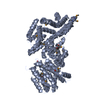
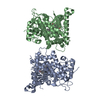
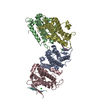
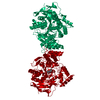
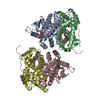
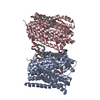
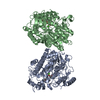









 Z (Sec.)
Z (Sec.) Y (Row.)
Y (Row.) X (Col.)
X (Col.)






















